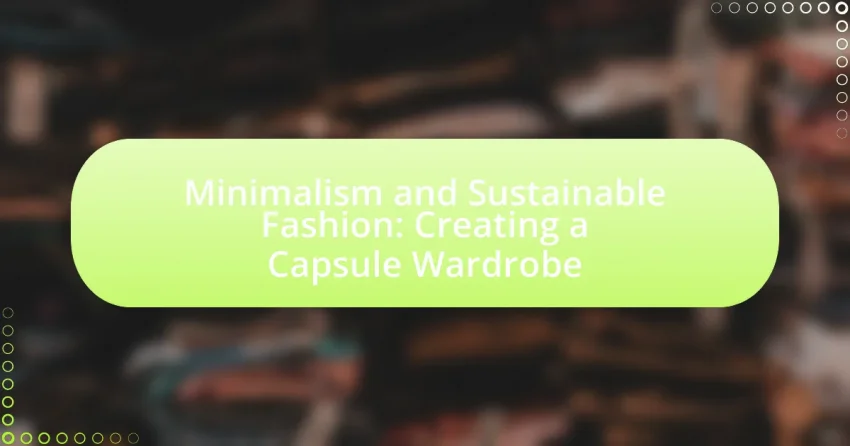Minimalism and sustainable fashion are interconnected concepts that emphasize simplicity and ethical practices in clothing consumption. This article explores the principles of minimalism in fashion, highlighting the importance of quality over quantity and the environmental benefits of sustainable fashion. It discusses the creation of a capsule wardrobe, which consists of a limited number of versatile pieces that promote mindful consumption and reduce waste. Additionally, the article provides practical tips for selecting essential items, maintaining a minimalist wardrobe, and identifying sustainable fashion brands, ultimately advocating for a conscious approach to personal style and environmental conservation.

What is Minimalism and Sustainable Fashion?
Minimalism is a lifestyle choice that emphasizes simplicity and the intentional reduction of possessions to focus on what truly matters. Sustainable fashion refers to clothing that is designed, manufactured, and consumed in a way that minimizes environmental impact and promotes ethical practices. Together, minimalism and sustainable fashion advocate for a conscious approach to clothing, encouraging consumers to invest in fewer, high-quality pieces that are environmentally friendly and ethically produced. This approach is supported by the growing awareness of the fashion industry’s significant contribution to pollution and waste, with the Ellen MacArthur Foundation reporting that the fashion sector is responsible for 10% of global carbon emissions.
How do minimalism and sustainable fashion intersect?
Minimalism and sustainable fashion intersect through the shared principle of reducing consumption and prioritizing quality over quantity. Minimalism advocates for a simplified lifestyle that emphasizes fewer possessions, which aligns with sustainable fashion’s focus on ethical production and environmentally friendly materials. By adopting a minimalist approach, individuals often choose to invest in versatile, high-quality garments that have a longer lifespan, thereby reducing waste and the demand for fast fashion. This intersection is supported by the growing trend of capsule wardrobes, which consist of a limited number of essential pieces that can be mixed and matched, promoting both sustainability and a minimalist lifestyle.
What principles define minimalism in fashion?
Minimalism in fashion is defined by simplicity, functionality, and a focus on quality over quantity. This approach emphasizes a limited color palette, clean lines, and versatile pieces that can be mixed and matched, promoting a streamlined wardrobe. The principle of sustainability is also integral, as minimalism encourages the reduction of waste through thoughtful purchasing and the use of durable materials. Historical context shows that minimalism gained prominence in the 1960s and 1970s, influenced by movements in art and design that favored simplicity and essential forms.
How does sustainable fashion contribute to environmental conservation?
Sustainable fashion contributes to environmental conservation by reducing waste and minimizing resource consumption. This approach emphasizes the use of eco-friendly materials, such as organic cotton and recycled fabrics, which require less water and energy to produce compared to conventional textiles. For instance, the production of organic cotton uses 91% less water than traditional cotton farming, significantly lowering the environmental impact. Additionally, sustainable fashion promotes ethical manufacturing practices that reduce pollution and carbon emissions, as brands often prioritize local production and fair labor conditions. By encouraging consumers to buy fewer, higher-quality items, sustainable fashion also helps decrease the overall demand for fast fashion, which is responsible for a substantial portion of global textile waste.
Why is creating a capsule wardrobe important?
Creating a capsule wardrobe is important because it promotes minimalism and sustainability in fashion. A capsule wardrobe consists of a limited number of versatile clothing pieces that can be mixed and matched, reducing the need for excessive purchases and minimizing waste. Research indicates that the fashion industry is responsible for 10% of global carbon emissions, highlighting the environmental impact of fast fashion. By adopting a capsule wardrobe, individuals can significantly decrease their consumption and contribute to a more sustainable lifestyle.
What are the benefits of a capsule wardrobe?
A capsule wardrobe offers several benefits, including reduced decision fatigue, increased versatility, and enhanced sustainability. By limiting clothing choices to a select number of versatile pieces, individuals can simplify their daily outfit decisions, leading to less stress and more time for other activities. The versatility of a capsule wardrobe allows for numerous outfit combinations, maximizing the use of each item and promoting creativity in styling. Additionally, a capsule wardrobe supports sustainable fashion practices by encouraging mindful consumption, reducing waste, and minimizing the environmental impact associated with fast fashion. Studies indicate that consumers who adopt a minimalist approach to their wardrobe tend to buy fewer clothes, which contributes to a more sustainable lifestyle.
How does a capsule wardrobe promote minimalism?
A capsule wardrobe promotes minimalism by significantly reducing the number of clothing items one owns, focusing on quality over quantity. This intentional selection of versatile, timeless pieces encourages individuals to prioritize essential items that can be mixed and matched, thereby minimizing clutter and decision fatigue. Research indicates that adopting a capsule wardrobe can lead to a more streamlined lifestyle, as it fosters a mindset of simplicity and intentionality in personal choices, aligning with the core principles of minimalism.

What are the key components of a capsule wardrobe?
The key components of a capsule wardrobe include a limited number of versatile clothing pieces that can be mixed and matched to create various outfits. Typically, a capsule wardrobe consists of essential items such as tops, bottoms, outerwear, and shoes, focusing on quality over quantity. For instance, a well-curated capsule wardrobe may contain around 30 to 40 items, which allows for easy coordination and reduces decision fatigue. This approach promotes sustainability by encouraging mindful consumption and reducing waste, aligning with the principles of minimalism in fashion.
How do you select essential pieces for a capsule wardrobe?
To select essential pieces for a capsule wardrobe, identify versatile items that can be mixed and matched for various occasions. Focus on quality over quantity, choosing timeless styles that align with personal aesthetics and lifestyle needs. Research indicates that a well-curated capsule wardrobe typically consists of 20 to 40 pieces, including tops, bottoms, outerwear, and shoes, which can create numerous outfit combinations while minimizing clutter. This approach not only promotes sustainability by reducing consumption but also simplifies daily decision-making regarding clothing choices.
What criteria should be used to choose versatile clothing items?
To choose versatile clothing items, prioritize factors such as adaptability, quality, and timelessness. Adaptability ensures that the clothing can be styled in multiple ways for various occasions, enhancing its usability. Quality is essential as it guarantees durability, allowing the item to withstand frequent wear and maintain its appearance over time. Timelessness refers to the item’s design, which should transcend seasonal trends, ensuring it remains relevant and fashionable for years. Research indicates that a well-curated wardrobe with versatile pieces can reduce consumption and promote sustainable fashion practices, aligning with minimalist principles.
How can personal style influence the selection of wardrobe pieces?
Personal style significantly influences the selection of wardrobe pieces by guiding individuals in choosing items that reflect their unique preferences and values. For instance, someone with a minimalist aesthetic may prioritize versatile, high-quality pieces that can be mixed and matched, while someone with a bohemian style might opt for colorful, patterned garments that express creativity. This alignment between personal style and wardrobe choices not only enhances individual expression but also promotes sustainable fashion practices, as individuals are more likely to invest in timeless pieces rather than fast fashion. Research indicates that consumers who identify with a specific style are more inclined to curate their wardrobes thoughtfully, leading to reduced consumption and waste, which is essential in the context of sustainable fashion.
What types of clothing should be included in a capsule wardrobe?
A capsule wardrobe should include versatile and timeless clothing items that can be mixed and matched. Essential pieces typically consist of a classic white shirt, a tailored blazer, a pair of well-fitting jeans, a little black dress, neutral sweaters, and comfortable shoes. These items are chosen for their ability to create multiple outfits while maintaining a cohesive style. Research indicates that a well-curated capsule wardrobe can reduce decision fatigue and promote sustainable fashion practices by minimizing excessive consumption.
What are the must-have items for every capsule wardrobe?
The must-have items for every capsule wardrobe include a classic white shirt, a tailored blazer, a pair of well-fitting jeans, a little black dress, versatile shoes, and a quality coat. These items are essential because they can be mixed and matched to create various outfits suitable for different occasions. For instance, a classic white shirt can be dressed up with a blazer for work or paired with jeans for a casual outing. Research indicates that a capsule wardrobe typically consists of 30 to 40 pieces, emphasizing quality over quantity, which supports sustainable fashion practices by reducing waste and promoting mindful consumption.
How can seasonal changes affect the contents of a capsule wardrobe?
Seasonal changes significantly affect the contents of a capsule wardrobe by necessitating the inclusion or exclusion of specific clothing items suited for varying weather conditions. For instance, during winter, heavier fabrics like wool and thermal layers are essential, while summer requires lighter materials such as cotton and linen. This shift ensures that the wardrobe remains functional and comfortable throughout the year. Additionally, research indicates that a well-curated capsule wardrobe can reduce the average number of clothing items needed, promoting sustainability by minimizing waste and encouraging mindful consumption.

How can you maintain a minimalist and sustainable wardrobe?
To maintain a minimalist and sustainable wardrobe, focus on curating a capsule collection of versatile, high-quality pieces that can be mixed and matched. This approach reduces clutter and encourages mindful consumption, as studies show that a smaller wardrobe can lead to less decision fatigue and greater satisfaction with clothing choices. Additionally, prioritize sustainable materials and ethical brands, as the fashion industry is responsible for significant environmental impact; for instance, the Ellen MacArthur Foundation reports that clothing production contributes to 10% of global carbon emissions. Regularly assess your wardrobe to remove items that no longer serve you, promoting a cycle of reuse and recycling, which further supports sustainability.
What strategies can help in decluttering your wardrobe?
To declutter your wardrobe effectively, implement the “one in, one out” rule, which requires removing one item for every new item added. This strategy helps maintain a manageable number of clothing pieces and encourages mindful purchasing. Additionally, categorize your clothing into keep, donate, and discard piles, which allows for a clear assessment of what you truly wear and need. Research indicates that individuals who regularly assess their wardrobe report higher satisfaction with their clothing choices and reduced stress related to decision-making about outfits.
How often should you reassess your capsule wardrobe?
You should reassess your capsule wardrobe at least twice a year. This frequency allows you to evaluate your clothing choices in relation to seasonal changes, personal style evolution, and lifestyle shifts. Regular reassessment helps ensure that your wardrobe remains functional and aligned with your current needs, promoting sustainability by reducing unnecessary purchases and waste.
What are effective methods for donating or recycling unwanted clothing?
Effective methods for donating or recycling unwanted clothing include donating to local charities, using clothing drop-off bins, and participating in clothing swaps. Charities such as Goodwill and Salvation Army accept gently used clothing, providing tax deductions for donors. Clothing drop-off bins, often found in community centers, allow for convenient recycling. Clothing swaps, where individuals exchange items, promote sustainability and community engagement. According to the Environmental Protection Agency, recycling textiles can divert over 11 million tons of clothing from landfills annually, highlighting the importance of these methods in promoting sustainable fashion practices.
How can you shop sustainably for your capsule wardrobe?
To shop sustainably for your capsule wardrobe, prioritize purchasing high-quality, timeless pieces made from eco-friendly materials. Sustainable brands often use organic cotton, Tencel, or recycled fabrics, which reduce environmental impact. According to a 2021 report by the Ellen MacArthur Foundation, the fashion industry is responsible for 10% of global carbon emissions, highlighting the importance of choosing sustainable options. Additionally, consider second-hand shopping or clothing swaps to extend the life cycle of garments, as this practice significantly decreases waste and resource consumption.
What are the best practices for buying second-hand clothing?
The best practices for buying second-hand clothing include thoroughly inspecting items for quality, checking for stains or damage, and ensuring proper fit before purchase. When shopping, prioritize reputable thrift stores or online platforms with return policies to minimize risk. Researching the brand can also provide insight into the garment’s sustainability and ethical production practices. According to a study by the Ellen MacArthur Foundation, extending the life of clothing by just nine months can reduce carbon, water, and waste footprints by 20-30%. This highlights the environmental benefits of purchasing second-hand clothing.
How can you identify sustainable fashion brands?
To identify sustainable fashion brands, look for certifications such as Global Organic Textile Standard (GOTS) or Fair Trade, which indicate adherence to environmental and social standards. Brands that prioritize transparency in their supply chains, disclose their sourcing practices, and provide information about their production processes are also more likely to be sustainable. Additionally, brands that use eco-friendly materials, such as organic cotton or recycled fabrics, and implement ethical labor practices contribute to sustainability. Research shows that consumers increasingly prefer brands that demonstrate a commitment to sustainability, with a 2021 survey indicating that 66% of global consumers are willing to pay more for sustainable brands.
What practical tips can enhance your capsule wardrobe experience?
To enhance your capsule wardrobe experience, focus on selecting versatile pieces that can be mixed and matched easily. This approach allows for a variety of outfits while minimizing clutter. Research indicates that a well-curated capsule wardrobe typically consists of 30 to 40 items, which can include clothing, shoes, and accessories, ensuring that each piece serves multiple purposes. Additionally, regularly reassessing your wardrobe to remove items that no longer fit your style or needs can maintain its effectiveness and relevance. This practice not only promotes sustainability by reducing waste but also simplifies daily outfit choices, aligning with the principles of minimalism in fashion.
How can you style a limited number of pieces creatively?
To style a limited number of pieces creatively, one can mix and match items to create diverse outfits, utilizing layering techniques and accessories to enhance versatility. For example, a basic white shirt can be paired with different bottoms, such as jeans, skirts, or shorts, and layered with cardigans or jackets to achieve various looks. Accessories like scarves, belts, and jewelry can transform the same outfit, adding unique elements that reflect personal style. This approach aligns with the principles of minimalism and sustainable fashion, as it maximizes the use of fewer items while promoting creativity and individuality in styling.
What are common challenges in maintaining a capsule wardrobe, and how can you overcome them?
Common challenges in maintaining a capsule wardrobe include limited variety, difficulty in seasonal transitions, and the temptation to purchase new items. To overcome limited variety, individuals can focus on versatile pieces that can be styled in multiple ways, ensuring that each item serves multiple purposes. For seasonal transitions, planning ahead and selecting a few key pieces that can be layered or adapted for different weather conditions can help maintain functionality. To combat the temptation to buy new items, setting strict guidelines for purchases, such as a one-in-one-out rule, can reinforce commitment to the capsule concept.
